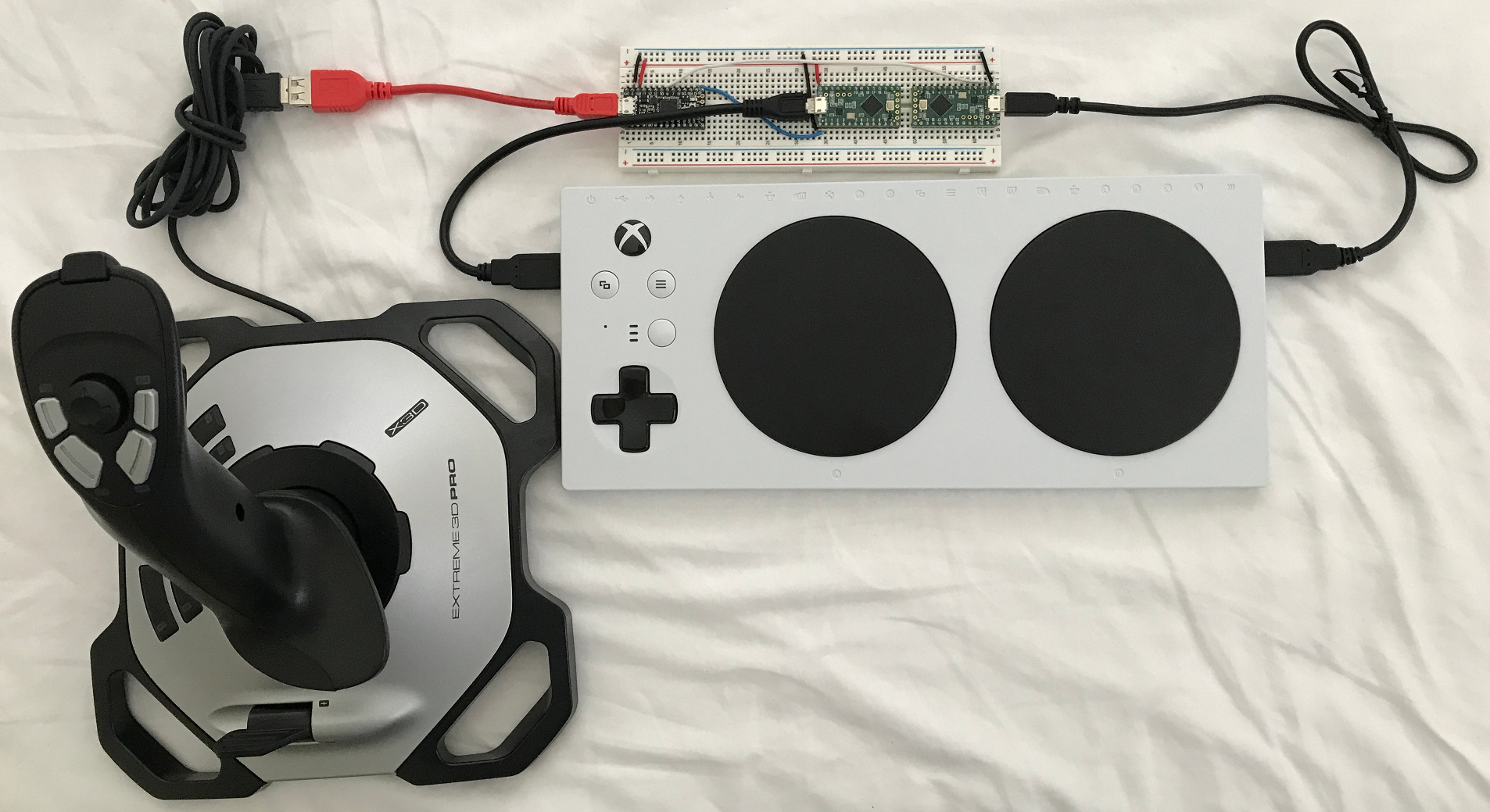The Microsoft Xbox Adaptive Controller (XAC) ignores the hat switch on the Logitech Extreme 3D Pro flight stick. The joystick splitter project is one way to solve this problem using Arduino compatible boards.
NOTE: A few people have pointed that using joysticks, keyboards, mice, head trackers, etc. with consoles is not new. If you do not need the XAC for button and switch inputs, consider the following alternatives. Or use one of the following with an XAC if you do not want to bother with building the joystick splitter. I have not used any of them so you will have to investigate on your own.
- Joystick X,Y maps to the left thumbstick
- Hat 8-way switch maps to the right thumbstick
- 4 top buttons map to A, B, X, Y
- Front trigger maps to right bumper
- Side trigger maps to left bumper
- Throttle
- Joystick Z axis (twist)
- Configuration file to remap controls but this can be done using the console.
- 1 x Logitech Extreme 3D Pro Flight Stick (LE3DP)
- 1 x Microsoft Xbox Adaptive Controller (XAC)
- 1 x Adafruit ItsyBitsy M0 (IBM0)
- 1 x USB OTG to host cable or adapter
- 2 x PJRC Teensy LC boards (TLC)
- 2 x USB cable with micro USB connector
- Breadboard, headers, wire, etc.
- joyuart -- Joystick emulator for Teensy LC boards
- joysplit -- Joystick USB host for ItsyBitsy M0
The LE3DP plugs into the ItsyBitsy M0 via the USB OTG cable. The IBM0 can talk to the LE3DP because the IBM0 works in USB host mode. The joysplit code running on the IBM0 extracts the joystick axes, hat switch, and buttons events. joysplit sends the joystick events to one Teensy LC (TLC) and the hat switch events to the other TLC. The button changes are divided up as needed so the defaults are useful. One TLC plugs into the Xbox Adaptive Controller (XAC) left USB port and the other plugs into the XAC right USB port. The IBM0 and TLCs talk to each other via UART ports.
The result is the big joystick works as the Xbox left stick and the hat switch works as the Xbox right stick. The top buttons work as A, B, X, Y, right bumper, and left bumper.
The TLCs are powered over USB from the XAC. One TLC powers the IBM0 which in turn powers the LE3DP.
- Install Arduino IDE 1.8.7. Follow the insturctions at arduino.cc.
- Use IDE board manager to install the Arduino SAMD board package.
- Install the Adafruit SAMD board package following the directions at adafruit.com. Be sure the IBM0 board works before continuing.
- Install USB Host Library for SAMD using "git clone" or by downloading a zip file.
- Set the board type to Adafruit ItsyBitsy M0 then upload joysplit.ino.
- Use the same Arduino IDE as above.
- Install TeensyDuino 1.44. Follow the instructions at pjrc.com.
- Unzip the patches for the joystick (joystick_teensy_20181107.zip) over the TeensyDuino files.
- Set the board type to Teensy LC and the USB Type to Joystick. Do not use the other USB Type options for joystick. They do not work with the XAC.
- Upload joyuart to the TLCs.
In both cases, the IDE automatic upload will not work once the programs have been uploaded. The solution for the IBM0 is to double click the reset button to put it in upload mode. The solution for the TLC is to click the program/reset button once to upload.
Connect the boards as shown in the photo. Bread board connections can get loose and unreliable after a while. Soldering everything down on proto board results in a permanent solution.
Connections between boards.
| Left TLC | ItsyBitsy M0 | Right TLC |
|---|---|---|
| GND | GND | GND |
| 5V | USB | --- |
| 0-RX | 1-TX | --- |
| --- | 10-TX | 0-RX |
The photo is touched up to clarify the wiring connections. Due to the wonders of parallax, the wires on the far right and left appear to be off by one pin without touch up.


